In the mornings, Edwardian maids wore striped cotton dresses – usually blue & white striped or pink & white striped. They only changed into the today’s known black & white maid costume – a black wool dress with white cotton apron & cap – in the afternoons.
Cotton dresses were much more practical than wool dresses for housework. They were lighter, cooler and could be washed in contrast to Edwardian wool dresses. That’s why these type of dresses were usually called ‘wash dresses’ or ‘tub frocks’ in the 1900s.
Related: How To Dress In The Edwardian Era
‘Every girl should try to dress in keeping with the work that she is doing. It would look very inappropriate to see an office girl at work in an evening dress. It would look just as inappropriate to see a woman or girl at work in the house dressed in worn-out finery.’ (School Sewing Based On Home Problems, 1916)
Antique Edwardian Maid Dress Inspirations
My main inspirations were this 1905 pink gingham cook’s dress with a white cotton apron, this beautiful 1901-3 pink gingham cotton day dress and this antique Edwardian photograph of a striped servant’s dress with apron.
And here’s a painting of a maid wearing a pink wash dress and apron, a 1900s photograph of maids wearing aprons and caps, and another photograph of a nanny’s morning uniform with apron and cap. And I pinned even more inspirations to my pinterest board: 1900s Washdress and Maid Dress.
‘The maids wear during the morning print gowns of light tint similar to those used for the uniform of hospital nurses […] with heavy white linen bib apron and […] caps which are often merely flat loops of linen with scalloped edges, drawn together in the center’ (Los Angeles Herald, 1908).
Pink & White Striped Cotton Fabric
I also love blue & white striped dresses. But I finally decided to sew a pink & white striped dress. This type of fabric was called gingham in the 1900s. By the way, in the Edwardian era, cotton gingham fabric was often striped instead of today’s checked gingham fabric.
I needed 4 meters of the pink striped cotton fabric for my Edwardian maid dress.
Antique Pattern & Sewing Instructions
The bodice and skirt of my Edwardian maid outfit are separate which is typical for early Edwardian dresses. The shirtwaist bodice is based on this antique 1911 and this 1916 free sewing patterns. And the skirt is based on this free antique Edwardian sewing pattern: the 1901 skirt Astarte (without the flounce).
Related: Edwardian Maid Dress – The Skirt
I mainly followed these 1911 sewing instructions on how to make a cotton shirtwaist. And I also followed these 1916 instructions on how to make a gingham house dress except that I didn’t join the waist and skirt which wasn’t done until later in the Edwardian era.
Edwardian Maid Dress – Accessories
To complete my Edwardian maid costume, I also made a cotton apron and maid cap.
Related: 1900s Maid’s Cap With Streamers
I used 2 meters of white plain-weave cotton fabric for the Edwardian apron and maid cap with streamers.
Related: Edwardian Apron
Edwardian Underwear
Under the dress I’m wearing an Edwardian chemise, Edwardian corset, my Edwardian handkerchief camisole, and a cotton petticoat.
Related: How To Make An Edwardian Camisole From Handkerchiefs
I also wear black cotton stockings and Edwardian-style black leather lace-up boots.
Convertible Dress
By the way, my Edwardian maid costume is convertible. Without the accessories – apron and cap – the dress suddenly becomes a summer dress! In the 1900s, cotton dresses like this were often worn on a day trip to the river or beach.
My Edwardian maid outfit is so comfortable to wear. And the shorter hem is practical for working.
‘The correctly made tub frock is never fussy. No flapping draperies should be allowed, merely trim lines’ (Every Woman’s Encyclopaedia, 1910-2).
Related: The Edwardian Summer Girl
I made this Edwardian maid’s dress for the Historical Sew Monthly Challenge:
Challenge: 5 – Practicality
Fabric: pink and white striped 100% cotton gingham (woven, not printed), white 100% cotton fabric
Pattern: my own, adapted from antique 1900s patterns
Year: 1901-3
Notions: white pure cotton broderie anglaise lace, cotton sewing thread
How historically accurate is it? Very accurate (apart from modern fabric etc.). I used antique Edwardian patterns and followed antique Edwardian sewing instructions. I even used my antique treadle sewing machine to sew the dress. 😉
Hours to complete: 3 whole days – including pre-washing (shrinking) the fabric and ironing which took much longer than the actual sewing
First worn: for the photos
Total cost: 51,50$/ 45,95€: 34,18$/ 30,50€ for 4m gingham, 17,32$/ 15,45€ for 2m white cotton fabric
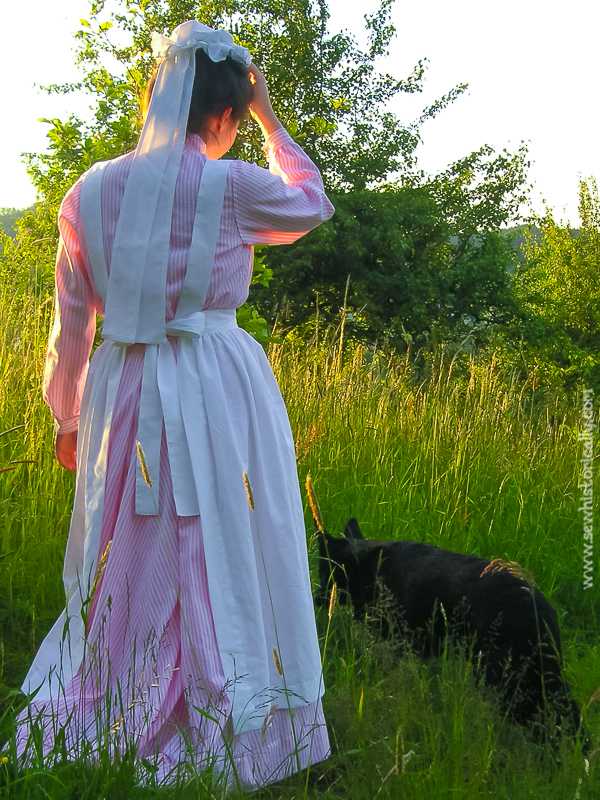
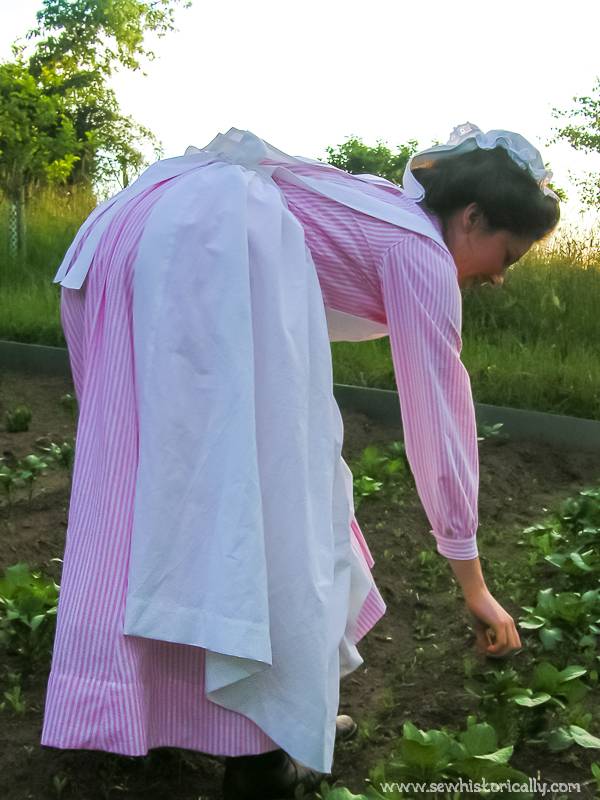
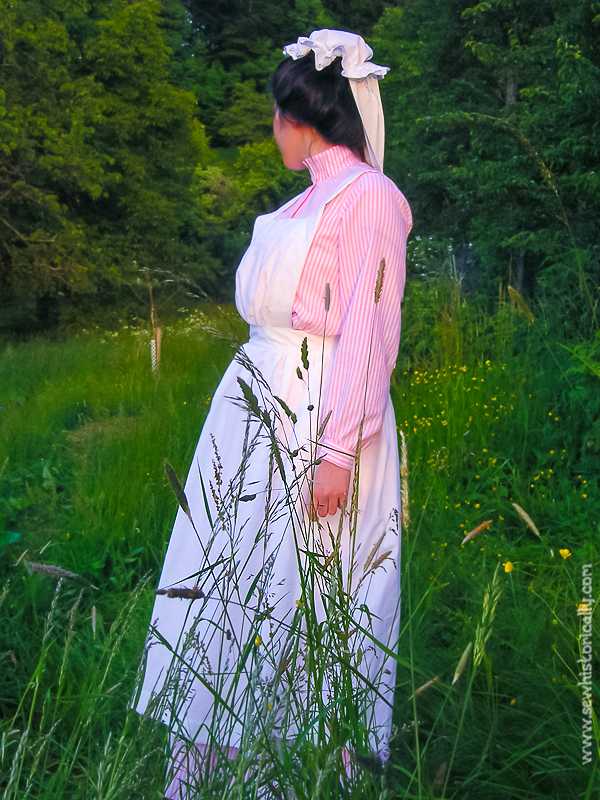
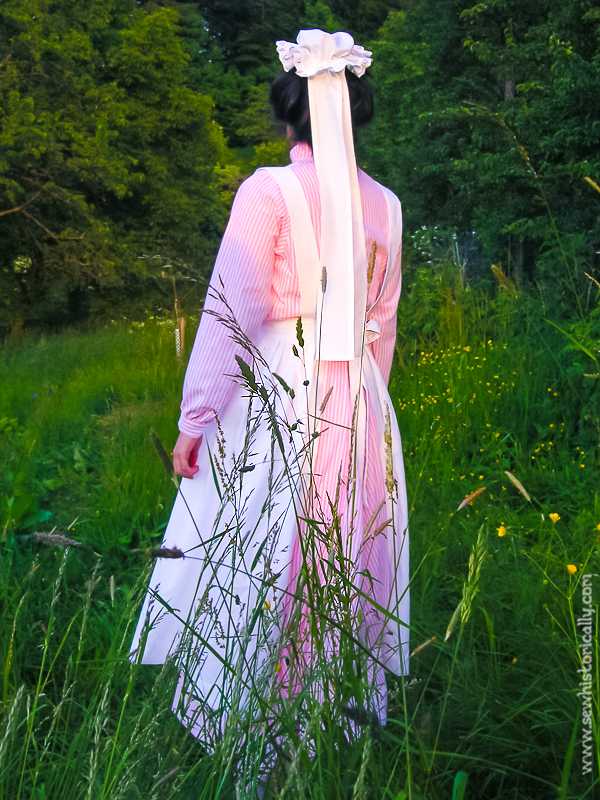
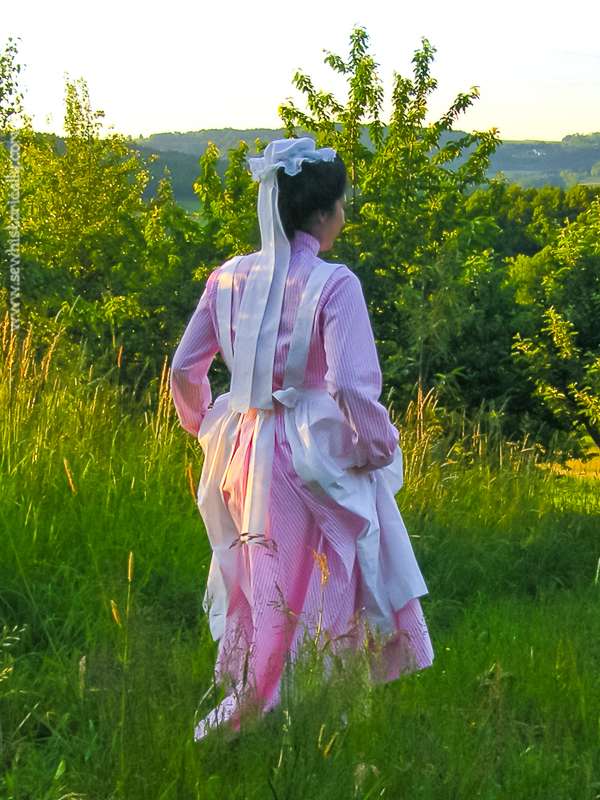
It’s lovely! I especially like that it doubles as a workdress and a summer dress.
Thank you! Yes, it’s really practical if a dress can be worn as ‘two’ dresses with different accessories.
Such a lovely the dress and dreamy pictures too! Great details about the history of these garments!!
Thank you, Preeti! 😀 The light was perfect on that day.
This is so lovely. I love your attention to detail in your posts. It’s really informative. I’m really glad to have found your blog through the Crafting on Link-up
Thank you for your lovely comment! 🙂
Brautiful dress and the photos are lovely also! Pinned!
Thanks for pinning!
Beautiful! Thanks for sharing at the #HomeMattersParty. I have been sewing for many years, also, but have never made time to learn about historical sewing techniques. This has piqued my interest – perhaps I will give this kind of sewing a try this autumn when my girls go back to school. Stop by when you can and visit me at Vintage Mama’s Cottage. Nina
Thank you, Nina! 🙂 I’d love to see your historical creations.
This is lovely, so much attention to detail. I like the idea you could just wear the blouse with non period clothes just for everyday.
Your photos are beautiful.
Thank you, Julie! 🙂
I love your photos and vintage dresses. Thanks for sharing @Vintage Charm–pinned!
Thanks for stopping by, Cecilia! 🙂
Your blog is fascinating, its really interesting to follow the quotes and the reasonings of the earlier eras. I really appreciate reading your posts. Enjoy your new dress its lovely.
Thank you, Leanna! 🙂 I love the dress and it’s really comfortable to wear despite all the underwear.
I absolutely love your blog. All your sewing projects are so beautiful. What fabric weight did you use for this dress? It looks perfekt.
Thank you so much! 😀 I used a lightweight cotton fabric (150gsm).